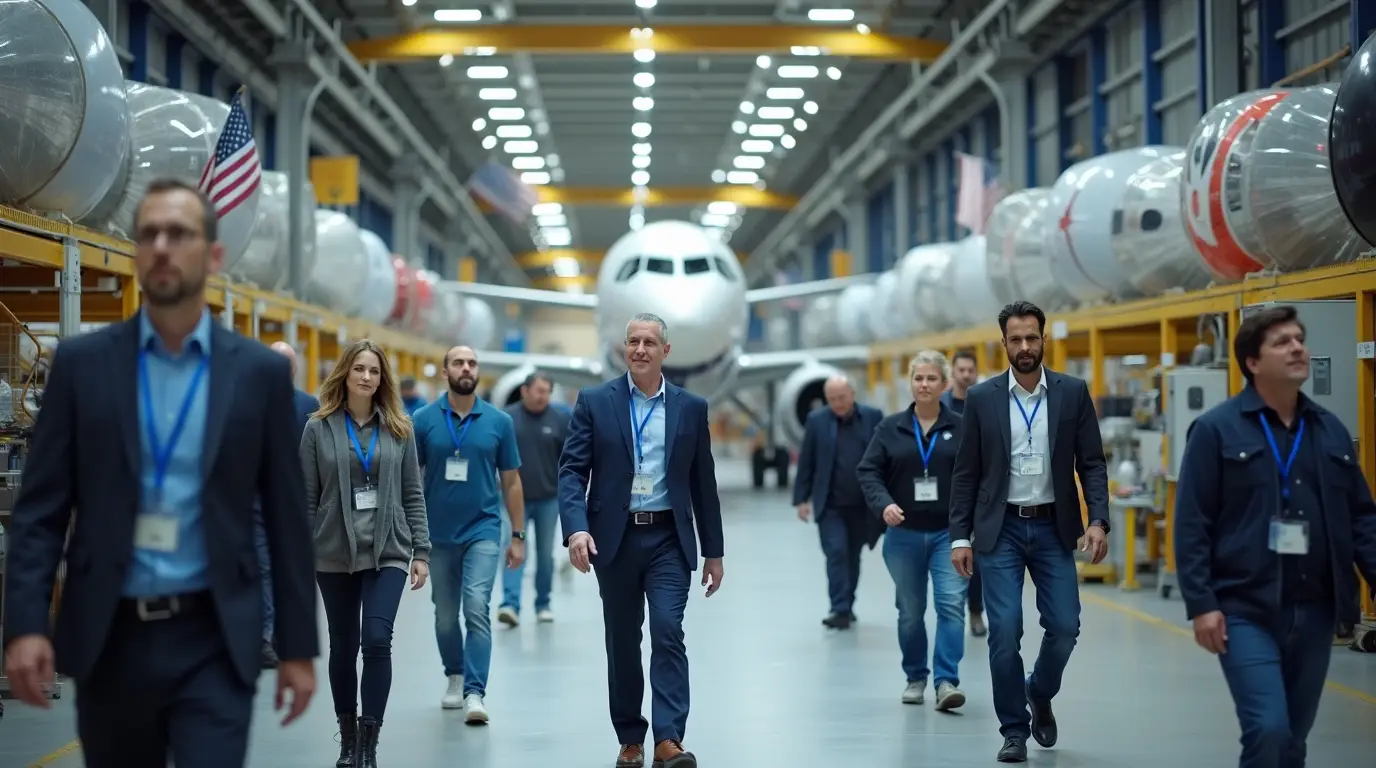Washington State is unquestionably the market leader of aerospace, generating near 95% of all commercially assembled aircraft within North America—the impetus being Boeing's large-scale main assembly centers as well as an extensive cluster of more than 1,500 aerospace suppliers (Washington State Department of Commerce, 2023; City of Spokane Valley, n.d.). Large-scale main assemblies of such magnitudes involve extensive security background screenings for enforcement of strict federal regulations. ITAR (International Traffic in Arms Regulations), EAR (Export Administration Regulations), facilities-specific badging requirements, as well as federal security clearances, are necessary for working efficiently within the very tightly regulated as well as very competitive aerospace sector.
Key Takeaways
- Washington State's aerospace industry necessitates rigorous security background checks due to its significant role in national aircraft production.
- Federal bodies like the Department of State, Commerce, Defense, and Homeland Security enforce regulations critical for aerospace compliance.
- ITAR and EAR compliance are crucial in preventing unauthorized technology leaks and safeguarding sensitive defense materials.
- Implementing robust company-owned badging systems is essential for controlling access to aerospace facilities and ensuring security.
- Adapting to regulatory changes and leveraging new technologies can enhance your compliance efforts and maintain your competitive edge in aerospace.
Introduction
Background checks aren't just about ticking boxes—they protect national security and prevent technology leaks. Delays in security clearances can be frustrating, especially when trying to fill positions with the right talent. By committing to a thorough understanding of the requirements, you equip yourself to handle these challenges effectively.
Expect clear guidance on the security screening processes specific to Washington’s aerospace sector. Whether you're struggling with regulatory hurdles or clearance timelines, this guide promises insights to streamline your compliance efforts. Let's break down the barriers to smart, efficient background screening in aerospace, ensuring you stay compliant and competitive.
EXPERT INSIGHT: As professional human resources, we often find ourselves at the intersection of compliance and compassion. In aerospace, where security clearances can be intimidating, we can lose sight of the reality that we are not dealing with paperwork, but rather people with skills, dreams, and loved ones. Behind every background check is a person willing to pour themselves into a greater mission than themselves. Our charge is to maintain national security but, more than that, open doors in a thoughtful way. If we undertake this work with thoroughness, sensitivity, and a consistent regard for fairness, we create teams that not only successfully clear but move big missions forward. - Charm Paz, CHRP
Washington Aerospace Security Regulatory Framework

Understanding the framework governing background checks and security in Washington's aerospace industry is pivotal for ensuring compliance and maintaining national integrity.
Key Federal Regulatory Bodies
If you're navigating Washington aerospace background checks, you need to know the federal players involved. The Department of State (DOS) plays a central role by managing ITAR, handling everything from administration to licensing. They're your go-to for anything regarding arms exports. Next, the Department of Commerce (DOC) oversees Export Administration Regulations (EAR). Think dual-use technology—anything with both commercial and military applications falls under their watch.
The Department of Defense (DoD) is crucial for security clearances. If a role demands a different level of access, the DoD processes and oversees these clearances, making sure those in sensitive roles meet all criteria. Lastly, we have the Department of Homeland Security (DHS), which handles the Transportation Worker Identification Credential (TWIC). This is essential for those accessing secure areas in U.S. ports and other facilities.
Have you mapped how these agencies affect your hiring and operational strategies? Knowing who does what can streamline compliance and reduce headaches.
Washington State Aerospace Landscape
Washington State stands as a powerhouse in aerospace production. Take Boeing, for instance: they manufacture a wide range of aircraft, from the nimble 737 to the expansive 787. But this isn't just about Boeing. Defense contractors like Lockheed Martin, Raytheon, and Northrop Grumman have also made Washington their home, integrating deeply into its aerospace fabric.
Behind the giants, a network of Tier 1, 2, and 3 suppliers and subcontractors maintain the supply chain's pulse. With over 1,400 aerospace businesses in the state, they're the backbone that supports both production and innovation.
Meanwhile, the space sector is taking off with companies like Blue Origin and SpaceX. These players push the boundaries of commercial space travel and exploration, adding to the region's dynamic aerospace footprint.
So why does this matter for background checks? Simply put, each layer—be it commercial aviation, defense, or space exploration—demands a robust approach to security. Stringent background checks protect national security and ensure compliance with ITAR and EAR regulations. With Washington's critical role in aerospace, thorough vetting isn't just beneficial; it's vital.
Does your company have what it takes to manage this complexity? Are your screening processes up to par with industry demands? Your answers could determine your place in Washington’s aerospace arena.
Why Aerospace Background Checks Are Critical
Background checks in aerospace serve as a frontline defense in protecting national security. They ensure that individuals handling sensitive defense technology are trustworthy. The stakes are high—imagine a situation where military secrets fall into the wrong hands due to inadequate screening. With countries vying for technological supremacy, maintaining strict controls over information and personnel is vital.
Export control compliance is another key factor. ITAR and EAR regulations are designed to prevent unauthorized technology transfers that might compromise national interests. Any breach can lead to severe penalties, not to mention national security risks, which could include advanced technologies or weaponry inadvertently aiding foreign powers.
Facility security is equally important. Aerospace manufacturers have sections that contain classified or controlled items. Access to these areas must be restricted to vetted individuals to prevent potential espionage. Consider the potential damage if unauthorized individuals access and misuse critical technology or data.
Finally, there's the matter of international competition. Staying ahead technically requires not just innovation but securing that innovation. Background checks act as a gatekeeper, ensuring that only those fully vetted are part of technological development teams. Are you doing enough to safeguard your tech and personnel in this highly competitive field?
ITAR Requirements
The International Traffic in Arms Regulations, or ITAR, form a crucial part of the U.S. defense export control system. When working in Washington's aerospace sector, understanding ITAR is non-negotiable. These regulations are designed to safeguard U.S. military technology, covering defense articles, services, and technical data.
ITAR Scope and Coverage
The International Traffic in Arms Regulations (ITAR) imposes strict export controls on a wide range of defense-related items, including military aircraft, firearms, missiles, satellites, and space technology, as outlined in the U.S. Munitions List (U.S. Department of State, n.d.; Varonis, n.d.). It regulates defense services, including technical support like training or engineering. Technical data, such as blueprints or software related to defense, fall under ITAR too. Even deemed exports, which occur when controlled technical information is shared with foreign nationals in the U.S., are tightly regulated.
ITAR Person Definition and Screening
The screening process under ITAR begins with identifying who qualifies as an "ITAR person." U.S. persons, including citizens, permanent residents, and certain protected individuals, are typically eligible to work with ITAR-controlled data without additional clearance. However, foreign persons require special authorization, posing challenges for companies hiring dual citizens or foreign nationals on visas like H-1B or L-1. Each worker’s status needs careful verification to ensure compliance with ITAR.
ITAR Background Check Components
ITAR background checks start with citizenship verification, ensuring all documents such as passports or birth certificates are valid. Criminal history reviews are vital; this often includes FBI checks and court record examination. Employment history is another focus, especially previous roles in aerospace or defense. Moreover, ITAR requires disclosure of foreign contacts and travel history to identify any potential security risks.
ITAR Compliance Obligations for Employers
Employers must register with the Department of State to handle ITAR-controlled items. Export licensing is necessary to legally transfer controlled technology to foreign persons. Regular employee training on ITAR compliance is a must, keeping everyone informed of the latest obligations and practices. Accurate and detailed record-keeping supports audits and ensures long-term compliance.
Violations hurt not just your company's reputation but its operational capabilities. Why risk it? Staying compliant with ITAR helps your business avoid unnecessary risks and keeps the doors open to attractive opportunities. Are your current practices enough to avoid these penalties?
EAR Requirements
Export Administration Regulations (EAR) are essential for controlling the distribution of dual-use items—equipment and technology that have both commercial and military applications. Washington’s aerospace industry is at the forefront of managing these requirements. Understand these key aspects to ensure compliance in your operations.
EAR vs. ITAR Distinction
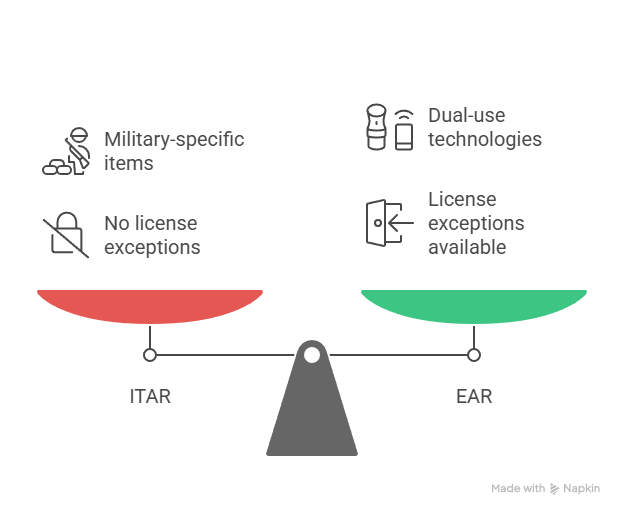
At its core, the difference between EAR and ITAR comes down to the type of goods and technology being controlled. EAR covers "dual-use" technology. These are items developed primarily for commercial purposes but could have military applications. Think of advanced computers or encryption software. These aren't designed for military use, but they hold value in that domain nonetheless.
The Commerce Control List (CCL) plays a crucial role here. It specifies what falls under EAR. If you're dealing with anything on this list, you're in the EAR territory. Technology transfer under EAR means any situation where controlled technology is shared. It’s not just about shipping physical items; sharing technical specifications orally or visually can also count.
Don't let the term "license exceptions" lead you astray. It's not a free pass. To qualify for exemptions from obtaining licenses, specific criteria must be met. For example, low-risk exports might not need a license. However, if you misjudge this, you risk hefty penalties.
In practical terms, think of mixing and matching a little regulatory puzzle. You must know which pieces belong to which framework to maintain compliance. This approach requires precision and understanding. Moving forward without grasping this distinction could trip up your compliance efforts. Are you confident about sorting your tech under EAR or ITAR? This distinction is the first step in ensuring you're following the right rules.
EAR Background Check Requirements
Restricted Party Screening is crucial before proceeding with EAR-controlled activities. You must verify individuals and entities against lists such as the Denied Persons List and the Entity List. This process helps prevent unauthorized tech transfers to restricted parties.
"Know Your Customer" protocols are more than just a nice to have. Implement due diligence on clients and business partners to confirm they are legitimate and trustworthy. Dig into their business practices, history, and affiliations because these relationships can affect your compliance status.
Employee Screening is mandatory for anyone with access to technology under EAR restrictions. You need thorough checks to ensure that staff members don’t pose a risk of inappropriate tech transfer. Review their past employment records, legal issues, and overall trustworthiness.
Foreign National Considerations are essential when dealing with global workforces. Be aware of deemed export regulations that control what information can be shared with non-U.S. individuals. This means special attention to visa statuses and potential dual citizenship implications.
Handling these components effectively can prevent compliance slip-ups. Are you prepared to ensure none of your connections are a liability?
EAR Compliance Programs
Implementing robust EAR compliance programs is essential for safeguarding your organization from potential violations. Start with internal controls. Develop clear, written policies on export control procedures. These should articulate the responsibilities of each employee involved in handling controlled technologies. Your policies will serve as the foundation upon which you build compliant practices.
Training programs are equally crucial. Educate employees about EAR guidelines with regular training sessions. These sessions should cover key compliance areas, common pitfalls, and updates on regulatory changes. Consider interactive approaches, like workshops or e-learning modules, to ensure the information sticks.
Recordkeeping is another cornerstone. Document all compliance activities meticulously. Store records of export licenses, screening results, and communication logs. You might need these during audits or regulatory reviews. A lack of proper records can lead to compliance headaches.
Audit procedures should be part of your routine. Schedule regular reviews of your compliance practices. Audits can uncover gaps before they become issues. Use them as an opportunity to refine your processes and address any weaknesses.
By following these practical steps, you can establish a solid EAR compliance framework. This not only reduces risk but can also enhance your organization's reputation for reliability and adherence to regulations. Are your current procedures up to the task, or is there room for improvement?
Technology Control Plans (TCP)
Managing who can access sensitive technology is crucial for EAR compliance. Your TCP should establish strict access controls to ensure only authorized individuals can reach sensitive data. Consider creating specific user roles based on need, reducing the risk of unauthorized tech access. Physical security measures also support an effective TCP. Storing sensitive material in secure, monitored locations minimizes unauthorized handling.
Your information systems need robust protection against breaches. Employ encryption and multi-factor authentication to safeguard electronic data transfers. Keeping software patched and updated can deter cyber threats.
Visitor management is another layer of security. Implement a system for logging visitors and restricting their access to specific areas under supervision. These steps collectively ensure that your technology remains secure and compliant with EAR guidelines. Are your current systems up to the task? If not, it's time to revise and reinforce your TCP.
Company-Owned Facility Badging Systems
Aerospace Facility Security Requirements
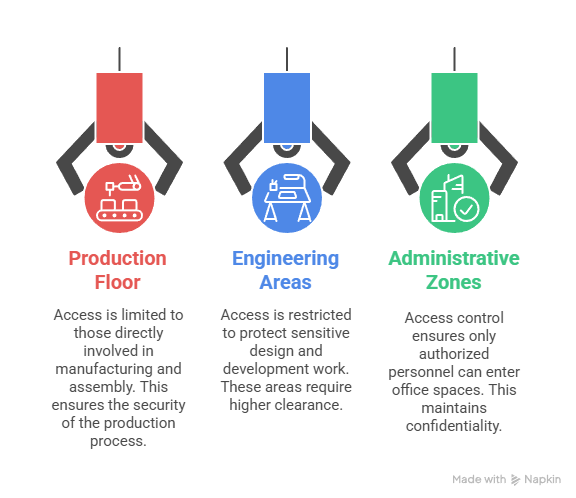
Access control within aerospace facilities isn't just a formality—it's a fundamental security measure. Imagine your company as a fortress where information and technology are the treasures. To protect these valuables, you need a robust badging system. Multi-level access is your first line of defense. Employees don different clearance levels based on their roles, which determines the zones they can enter.
On the production floor, access is restricted. Only badge holders assigned to manufacturing and assembly have entry. This means your engineers won't freely wander into production unless their badge permits it. Separate clearance handles engineering areas, often dealing with sensitive design and developmental processes. This ensures that only authorized personnel can engage with proprietary information.
Even administrative zones aren't a free-for-all. Access needs validation, as even a misplaced document here can create vulnerabilities. It's about balancing security with the freedom staff needs to perform effectively. By implementing these systems, you limit exposure and control the flow of personnel based on trust and necessity.
Have you considered how access might be differently structured at facilities overseas? What reflects best practices there? If you're planning an upgrade or overhaul, think about aligning with industry standards while adapting to your unique operational structure. With these insights, you'll be better equipped to make informed decisions that bolster your facility's security.
Badging System Components
Setting up a robust badging system is crucial for these facilities. Aerospace companies conduct thorough background investigations either in-house or through third parties. This might include fingerprint processing for verification with the FBI and state authorities. You’ll often see reference verification steps, checking employment and personal references. Regular monitoring is also a staple, ensuring badge holders maintain the clearance they require.
Access Level Classifications
When it comes to aerospace facilities, not all areas are created equal. Access must be carefully controlled to protect sensitive information and technology. You’ll encounter four primary classifications.
- Public Areas: These are spaces where visitors and employees can freely move. Think lobbies or conference rooms. Security here ensures smooth operations, while maintaining an inviting atmosphere.
- Controlled Areas: Access becomes more restricted. Here, you might find technical facilities or essential support areas. Employees receive clearance based on their role and need. This is the domain where trade secrets and proprietary technology start to come into play.
- Restricted Areas: Only authorized personnel with specific clearances can enter. These include zones for sensitive programs, manufacturing sites, and areas housing strategic data. Ensuring the right people have access minimizes risks and secures critical operations.
- Special Access: Even more exclusive, requiring additional clearances beyond standard qualifications. This might include working with extremely sensitive projects or material. It’s crucial to adhere to all protocols to maintain both security and compliance.
How do you determine which level someone needs? Consider the tasks they'll perform and the information at their fingertips. Matching access level with necessity saves time and avoids potential breaches. Could your current system benefit from revisiting or refining these classifications?
Badge Management and Maintenance
Issuing badges is more than handing out an access card. Start with a thorough background investigation. This can be handled internally or by a third-party vendor. It's crucial to ensure that every badge holder has been vetted properly before they set foot in sensitive areas.
Keep tabs on the badge renewal process. Periodic background checks should be part of it. This keeps your records up to date and maintains a secure environment. Set clear deadlines and communicate them to all employees to avoid unauthorized access due to expired credentials.
Be ready to revoke access immediately when necessary. Quick action is essential if there's a security threat or if an employee departs under questionable circumstances. Make this part of your exit procedures to avoid lapses in security.
Visitor escorts are not a luxury—they’re a safeguard. Ensure that every temporary badge comes with a designated escort. This not only protects your information but also maintains order in controlled areas. Brief your staff on the protocol to avoid any slip-ups.
Federal Security Clearance Integration

Handling federal security clearances within Washington's aerospace sector necessitates understanding various clearance levels and their implications. This knowledge facilitates smooth integration into employment processes and ensures compliance with federal standards.
Security Clearance Levels
Clearance comes in three principal levels: Confidential, Secret, and Top Secret. Each level grants access to different tiers of security information. Confidential is the starting point, suitable for basic classified material. Secret clearance allows access to more sensitive data relevant to national security. Top Secret is the most restrictive, reserved for highly sensitive information whose exposure could cause grave damage. Special Access Programs (SAP) require additional allowances and are for specific protected data and projects.
Clearance Processing Timeline
Obtaining a security clearance is not immediate. The initial investigation phase ranges from 6-18 months for Secret and 12-24 months for Top Secret. Interim clearances may be granted to allow employment commencement during this period. Adjudication is the subsequent step where the gathered information is analyzed to make a final clearance decision. Reciprocity agreements streamline the process by allowing clearance transfers among federal agencies, ensuring efficiency and continuity.
Clearance Investigation Process
The process begins with the Standard Form 86 (SF-86), a comprehensive questionnaire detailing personal and professional backgrounds. Field investigations follow, including interviews with colleagues, friends, and family to corroborate information. In specific roles, polygraph examinations are conducted to verify truthfulness. To retain the clearance, reinvestigations occur every 5-10 years, ensuring ongoing eligibility.
Maintaining Active Clearances
Active clearance maintenance requires continuous evaluation and incident reporting for events that might influence your clearance status. Foreign travel needs prior approval, with a debrief required upon return. Financial stability is also monitored, as significant debt or bankruptcy could raise security concerns. Active engagement in self-reporting and compliance upholds clearance integrity.
Understanding these elements is crucial for aerospace employers and employees in Washington, where federal clearance is often a job prerequisite. Recognizing the processes and requirements aids in navigating the complexities of security clearance efficiently.
Employer Compliance Implementation Guide
For Aerospace Employers
Establishing a strong compliance program is essential. Begin by defining clear screening policies that align with ITAR, EAR, and DoD requirements. Each regulation has its distinct focus, but hiring a compliance officer helps integrate these demands seamlessly.
For effective facility security planning, design access control systems that delineate between public, controlled, and restricted areas. Ensure these systems are regularly tested and updated to adapt to new security challenges.
Choosing the right partners matters. Select qualified screening service providers who understand aerospace industry nuances. Check their track record on compliance, accuracy, and timeliness to avoid non-compliance pitfalls.
Implementing a robust background screening process is not just a regulatory requirement—it's a strategic asset. It secures your competitive edge by protecting your technology and maintaining national security. How can your current screening process be enhanced to better meet these objectives?
For HR Teams and Compliance Officers
Matching screening levels accurately to job requirements is key for regulatory compliance and efficient workforce management. As an HR professional or compliance officer in the aerospace sector, your role is pivotal in integrating background checks seamlessly into the hiring process. This ensures that each candidate meets the necessary security standards before stepping into sensitive roles.
Design a robust workflow that incorporates initial screenings at the earliest hiring stages. This helps avoid delays in onboarding and ensures that organizational security policies are met right from the start. Remember to maintain detailed compliance records which are essential for audits. Efficiency in documentation not only streamlines your processes but also provides a reliable track record for external review.
Regular staff training programs on regulatory mandates offer a proactive approach to compliance. By educating your HR teams about ITAR, EAR, and security clearance requirements, you enhance their ability to make informed decisions and reduce errors. Training keeps your teams updated on any changes in the regulatory landscape, ensuring your organization stays compliant.
Effective HR management in aerospace is about balancing stringent compliance needs with smooth operational flow. By taking these steps, you contribute to a secure and compliant workplace, ready to tackle the complexities of the aerospace industry's regulatory framework.
Risk Assessment and Management
Start by identifying potential security risks within your organization. Assess your vulnerabilities and create plans to mitigate them. Establish clear incident response procedures to handle any security breaches or incidents swiftly. Always look for ways to refine and enhance your security protocols, ensuring they meet current demands.
Technology and Automation
Adopt automated platforms that streamline background checks and enhance efficiency. Implement electronic access controls for badge management to ensure precise monitoring of facility access. Use compliance tracking software to maintain oversight of your regulatory obligations. By integrating your HR systems with security and compliance databases, you create a unified and efficient approach to managing your aerospace security needs.
Common Disqualifying Factors and Risk Assessment
Automatic Security Disqualifiers
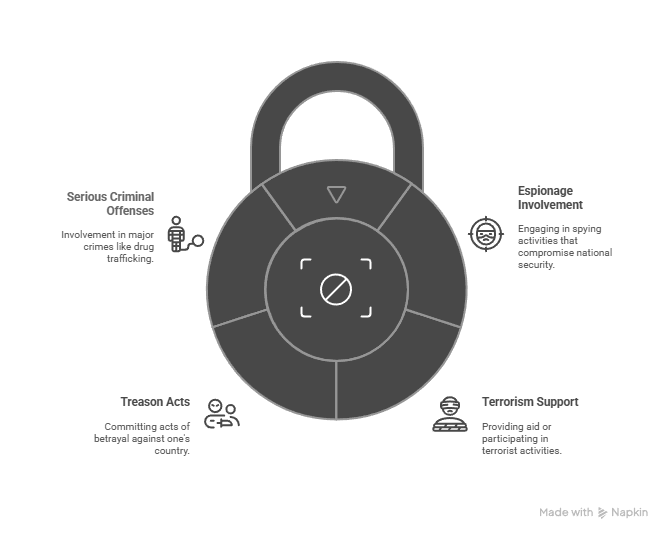
Some behaviors and actions automatically disqualify individuals from obtaining security clearances. Engaging in espionage tops the list. This involves gathering or transmitting data for foreign nations against the interest of the U.S. Similarly, any participation in terrorism or providing support to terrorist groups leaves no room for clearance consideration.
Treason, or acting deliberately against national security interests, results in an automatic disqualification. This covers a wide range of behaviors from attempting to overthrow the government to aiding enemies in wartime.
Involvement in serious criminal activity can also close doors quickly. For instance, significant involvement in drug trafficking not only affects your security clearance prospects but also severely limits employment in industries that are pivotal to national security.
If looking to advance in aerospace or defense sectors, keeping a clean record becomes crucial. Have you cross-checked your own history for any red flags?
Navigating your path through these criteria demands awareness and preemptive action. Lack of transparency or communication can turn a promising opportunity into an unnecessary setback.
What steps will you take today to ensure your background stands up to rigorous scrutiny?
Adjudicative Guidelines Assessment
Security background checks don't stop at disqualifications. They also assess financial responsibility, foreign influence, personal conduct, and substance use. Debts or bankruptcy can raise questions about vulnerability to coercion. Close ties to foreign entities might suggest divided loyalties. Consistently honest personal conduct and controlled substance use are paramount for reliability. Each case is weighed on its unique details.
Whole Person Concept
Understanding the "whole person" concept can aid your ability to navigate disqualifying issues effectively. This approach allows individuals to provide context around potential red flags in their background. For example, financial problems like a past bankruptcy might initially seem concerning. However, demonstrating consistent financial recovery and responsible behavior can mitigate these concerns.
Character references can play a crucial role here. Endorsements from credible figures, such as former supervisors or community leaders, help paint a broader picture of your reliability and trustworthiness. These external perspectives can counterbalance specific concerns, highlighting your growth and positive contributions.
Lifestyle changes matter as well. If past issues like substance abuse have impacted your record, showing evidence of sobriety and a stable lifestyle can favorably influence decision-makers. Documentation of your ongoing participation in support programs demonstrates commitment to maintaining improved behavior.
Finally, your interaction with the clearance process can reveal a lot. Openly and honestly answering questions during investigations exhibits integrity. This cooperation not only helps you build trust but also contrasts with any past indiscretions, showcasing your accountability and maturity. Taking proactive steps and demonstrating personal and professional development provide compelling evidence of your suitability for clearance.
Appeals and Remediation
If disqualified, there are avenues for appeal. Administrative reviews allow you to challenge a decision. Personal appearances at hearings provide a platform to present facts and advocate. Legal advisors with expertise in security clearances can offer strategic guidance. Remedial actions or corrective measures can address and possibly overcome initial disqualifications.
Job Seeker Navigation Guide
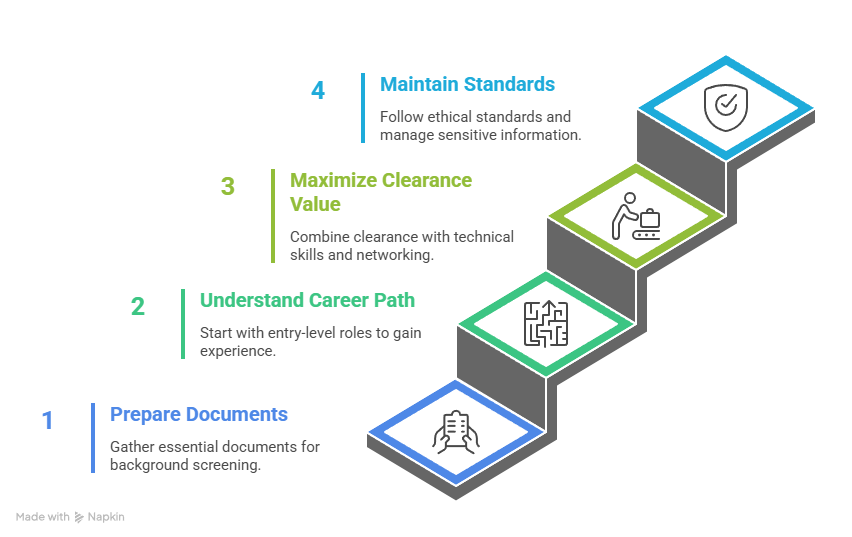
Preparing for Aerospace Background Screening
Starting a career in aerospace means navigating a host of background checks. Here's how you can set yourself up for success. First, conduct a self-assessment. This involves gathering a comprehensive snapshot of your background, including education, employment history, and any criminal records. Knowing your own profile can help you spot and address any areas that might need clarification or mitigation.
Next, prepare your documentation. You'll need to gather and organize essential documents like your social security card, proof of residency, and employment verification records. Birth certificates and passports are also typically required, ensuring your citizenship status is clear.
Time matters when dealing with security checks. The clearance process can be lengthy, so plan your timeline accordingly. Give yourself ample time not only for the initial application but also for any follow-up checks or documentation needs. Be proactive about this. Delays are common, and being prepared can help you manage them effectively.
Lastly, focus on your professional preparedness. Acquire skills and gain experiences that match the requirements of your desired role in aerospace. Whether it's technical expertise or specific certifications, aligning your skills with industry needs can enhance your job prospects and help you pass through the screening process smoothly.
Understanding Your Career Path
Entering the aerospace sector isn't just about technical skills; it's also about understanding the security requirements tied to your potential roles. For those beginning their careers, look for entry-level positions that don't mandate security clearances. These jobs offer a chance to gain relevant experience while familiarizing yourself with industry operations.
If you're aiming for roles requiring clearances, it's a gradual journey. Start with positions that need basic clearance and work your way up. As you accumulate experience and credentials, you can aim for more sensitive roles necessitating advanced clearances.
Specialization opens doors to career growth. Identifying programs tailored for cleared professionals not only enhances your expertise but also boosts your value within the industry. For example, aerospace companies often offer internal training and certification changes, facilitating continuous improvement.
Different regions have unique operational rules. Where you work might affect your requirements for security and clearance. Make sure you're aware of these geographic considerations. This can impact both the type of clearance you need and the waiting period for obtaining it.
Maximizing Your Clearance Value
Having a security clearance is more than just a formality; it’s a stepping stone for career advancement. Start by pairing your clearance with valuable skills. Technical competencies in areas like cybersecurity, engineering, or project management can enhance your career profile. Employers prize candidates who blend clearance with expertise.
Networking is another powerful tool. Build connections within the industry. Attend aerospace conferences, join professional associations, and participate in relevant forums. These connections can lead to job opportunities and insider knowledge, giving you a competitive edge.
Stay informed about industry trends and advancements. Whether it’s new regulations, technological innovations, or shifts in the geopolitical landscape, being informed keeps you relevant and prepared for new roles.
Consider the mobility that a clearance offers. While it can open doors within your current organization, it can also make you a hot prospect for other employers needing cleared candidates. This flexibility can be pivotal in navigating the aerospace employment landscape.
Are you actively engaging with mentors or industry leaders who can guide your career progression? How are you updating your skills to align with evolving industry demands? The answers to these questions can significantly impact how effectively you leverage your clearance.
Maintaining Professional Standards
Engaging in aerospace careers means staying vigilant about your conduct and responsibilities. Ethical conduct is non-negotiable. Align your actions with integrity and transparency. Missteps can derail your career, especially in roles requiring security clearances. When in doubt about a situation's ethical implications, seek guidance from a trusted advisor or HR professional.
You also have reporting obligations. Any changes in personal circumstances, such as financial troubles or foreign travel, might need to be disclosed. Meeting these requirements promptly can protect your clearance status.
Managing foreign contacts requires tact. If your job involves international relations, ensure all interactions are transparent. Understand the policies your employer has in place regarding foreign nationals and adhere strictly to them.
For technology protection, guard sensitive data with diligence. Employers rely on you to handle proprietary technologies and sensitive information responsibly. Familiarize yourself with and follow all security protocols your organization implements. Keeping software updated and securing your physical work environment are small steps that make a big impact.
Cost and Timeline Considerations
Background Check Processing Times
Getting clearances and badges can take some time, so be prepared. For company-owned badging, expect the process to take about 2 to 4 weeks. If you're dealing with ITAR screenings, you're looking at a timeline of 4 to 8 weeks. For EAR compliance, it typically takes 2 to 6 weeks. Security clearances are the real marathon here, ranging from 6 to 24 months depending on the clearance level needed.
Cost Analysis by Screening Type
Understanding costs can help you budget better. Basic aerospace screenings will set you back between $150 and $300 per candidate. If your situation requires enhanced ITAR or EAR screenings, be ready to pay anywhere from $300 to $600 for those specialized checks. Security clearances are more expensive, costing between $3,000 and $15,000 or more, depending on the level of clearance. Don’t forget ongoing monitoring costs, which range from $100 to $500 per year, per employee.
ROI and Strategic Value
Despite the costs, the return on investment is high. Being compliant opens the doors to lucrative contracts, which could contribute significantly to your revenue. With faster project execution, you maintain a competitive edge. Retaining talent with clearances is another strategic benefit. Plus, you minimize risks by avoiding costly penalties linked to compliance failures.
Budget Planning for Aerospace Employers
Employers need to consider these costs when planning budgets. Take into account the annual costs of screenings for your entire organization. Consider the clearance investment as adding long-term value to your workforce. Look into technology solutions to increase efficiency and reduce errors in your processes. Depending on your needs, professional services like legal advice and consultancy might be an additional cost, but they can save trouble down the line.
Conclusion
The aerospace background landscape in Washington continues to evolve rapidly, driven by regulatory reforms, technological advances, and workforce challenges. As ITAR and EAR regulations undergo modernization to streamline export processes, and security clearance protocols are enhanced for greater efficiency, companies must stay agile in their compliance strategies.
Emerging technologies like continuous vetting, biometric authentication, and AI-powered screening tools are transforming how background checks are conducted, offering real-time monitoring and improved accuracy. However, the industry faces significant workforce challenges, including skilled labor shortages and the complexities of managing remote work and international talent within regulatory constraints.
To succeed in this dynamic environment, aerospace companies must proactively adapt their hiring and compliance strategies. By embracing new monitoring technologies, streamlining clearance processes, and developing strategic approaches to international talent management, organizations can maintain competitive advantage while ensuring full compliance with Washington aerospace background check requirements.
Frequently Asked Questions
What does a Washington state background check include?
A Washington state background check typically includes criminal history, driving records, credit history, and verification of education and employment. It may also check for any outstanding warrants or court records.
How far back does a Washington state background check go for employment?
For most employment purposes, background checks in Washington state typically look back seven years, although this can vary depending on the employer and the nature of the job.
What background check do most employers use?
Most employers use comprehensive background checks that include criminal history, credit reports, and verification of past employment and education. Companies like Sterling, HireRight, and Checkr are popular providers.
Can you check on the status of a background check in Washington state?
Yes, you can check on the status by contacting the agency or company conducting the background check. They may provide online portals or customer service numbers for status updates.
How far back do most employers go on background checks?
Most employers typically look back seven years on background checks. However, positions with higher security clearance may require a more extensive review.
How much is a background check in Washington?
The cost of a background check in Washington can vary, typically ranging from $15 to $50, depending on the depth of the check and the agency conducting it.
What sort of things show up on a background check?
A background check may show criminal records, credit history, employment history, education verification, driving records, and any known aliases or addresses.
What rights do you have during a background check?
You have the right to be informed if a background check is being conducted on you for employment. You also have the right to dispute incorrect information found in the report.
How long does it take to complete a background check in Washington?
A typical background check takes anywhere from two days to a week, though more comprehensive checks may take longer.
Can a failed background check result in a job offer being revoked?
Yes, an employer can revoke a job offer if the background check reveals information that makes you unsuitable for the position.
What can you do if there’s an error on your background check?
If you find an error on your background check, you can dispute it with the reporting agency, providing any additional documentation or information necessary to correct the mistake.
Additional Resources
- Aerospace Competitive Economics Study 2022
https://choosewashingtonstate.com/wp-content/uploads/2023/02/Aerospace-Competitive-Economics-Study-2022.pdf - AAAC Final Report – January 22, 2024
https://app.leg.wa.gov/ReportsToTheLegislature/Home/GetPDF?fileName=AAAC+Final+Report+-+1.22.24+rt_44e0f421-03d4-4f77-a214-4bd0f1559a86.pdf - Washington State Ranks Most Competitive in U.S. for Aerospace Manufacturing
https://www.commerce.wa.gov/washington-state-ranks-most-competitive-in-u-s-by-a-wide-margin-for-aerospace-manufacturing/ - Want Higher Pay? These States Lead Cleared Compensation in 2025
https://news.clearancejobs.com/2025/04/29/want-higher-pay-these-states-lead-cleared-compensation-in-2025/ - U.S. Department of State. (n.d.). International Traffic in Arms Regulations (ITAR). https://www.pmddtc.state.gov/ddtc_public?id=ddtc_public_portal_itar_landing
- Varonis. (n.d.). What Is ITAR Compliance? https://www.varonis.com/blog/itar-compliance
- Washington State Department of Commerce. (2023). Industry strategy: Aerospace sector. https://governor.wa.gov/sites/default/files/2023-01/Industry_Strategy.pdf
- City of Spokane Valley. (n.d.). Aerospace. https://spokanevalleywa.gov/293/Aerospace
Still have questions?
Get in touch with our team today for a personalized demo and discover how our tailored volume pricing and packages can drive results for your business!
How useful was this page?*
Note: your comments are anonymous. We use them to improve the website. Do not include any personal details.
Visit our FCRA Compliance Tool or leave a message here if you need a response.
From the blog Explore the GCheck Content Hub

Employment Credit Checks: 2026 Guide to Legal Compliance and Best Practices
7 Jan, 2026 • 27 min read
I-9 Form Management Systems: Modernizing Employment Eligibility Verification for 2026
6 Jan, 2026 • 19 min read
EEOC Compliance Requirements 2026: Complete Employer Guide to Fair Hiring Practices
29 Dec, 2025 • 24 min readThe information provided in this article is for general informational and educational purposes only and should not be construed as legal advice or a substitute for consultation with qualified legal counsel. While we strive to ensure accuracy, employment screening laws and regulations—including but not limited to the Fair Credit Reporting Act (FCRA), Equal Employment Opportunity Commission (EEOC) guidelines, state and local ban-the-box laws, industry-specific requirements, and other applicable federal, state, and local statutes—are subject to frequent changes, varying interpretations, and jurisdiction-specific applications that may affect their implementation in your organization. Employers and screening decision-makers are solely responsible for ensuring their background check policies, procedures, and practices comply with all applicable laws and regulations relevant to their specific industry, location, and circumstances. We strongly recommend consulting with qualified employment law attorneys and compliance professionals before making hiring, tenant screening, or other decisions based on background check information.
